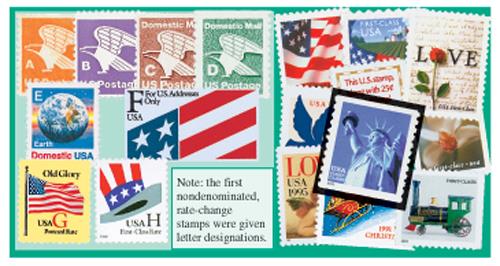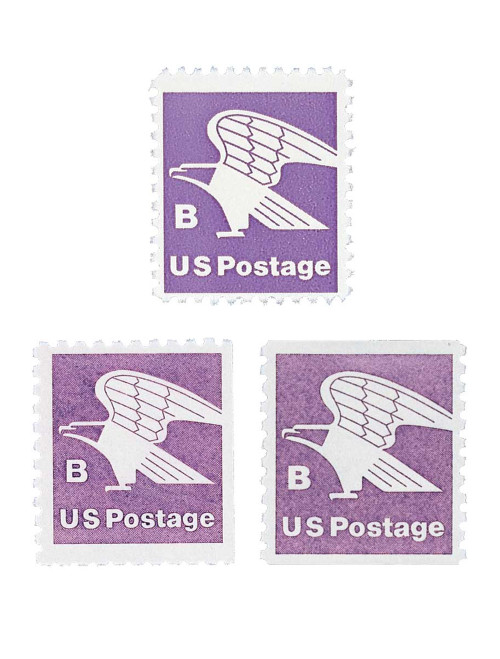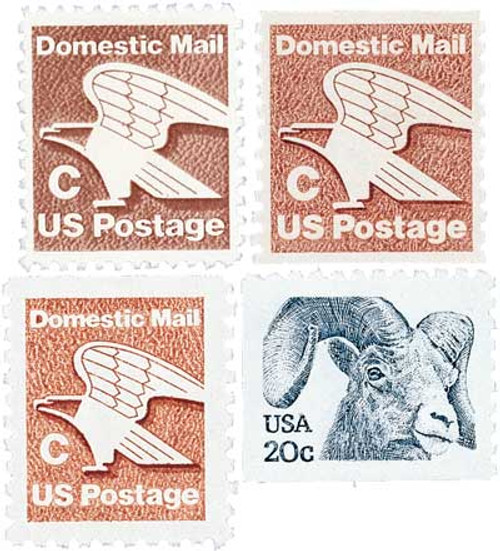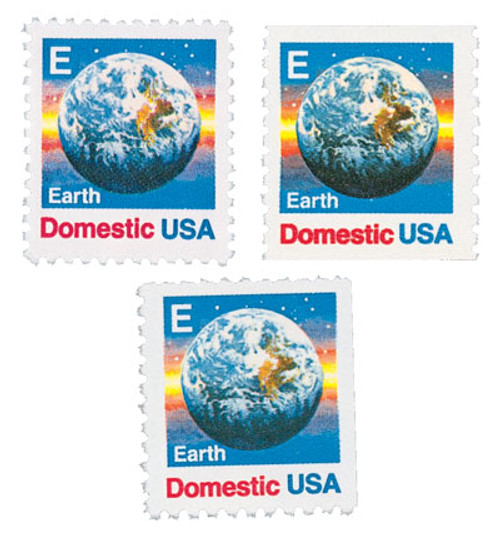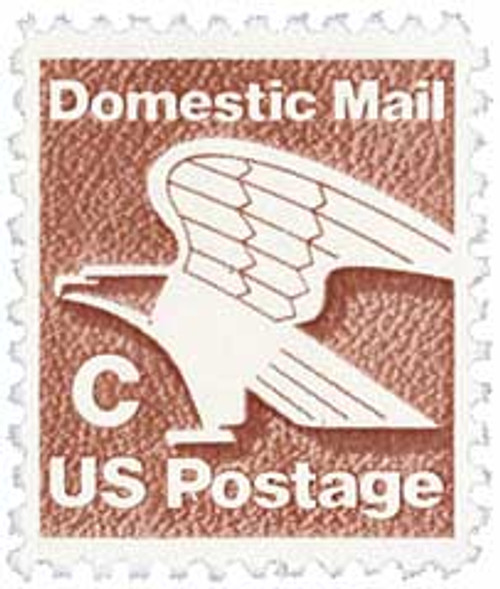
# 1946-48 - 1981 "C" Rate Change, set of 3 stamps
On November 1, 1981, a second postal increase, to 20¢, went into effect. Once again, the stylized eagle design was used and the background color was changed to brown. In addition to being printed in sheets and coils, the stamp was also printed in booklet format.
First Alphabet Rate Change Stamp
In the years prior, other stamps had been issued non-denominated for impending rate changes. Because postage rates for late 1975 were uncertain, both of the Christmas stamps that year (#1579 and #1580) were issued without denominations. These were the first non-denominated US stamps.
As postal costs increased, the USPS began to increase their rates for the various classes of mail. Before becoming effective, however, these rate increases had to be submitted to the Postal Rate Commission for approval. Often, the PRC would take as much as a year conducting studies and compiling data before accepting or rejecting the changes. If the rate increase was approved, the Postal Service then had to rush to design and produce the new stamps.

In 1975, after the rate had changed from 10¢ to 13¢, the Postal Service printed a new non-denominated stamp so it would be ready and waiting for the next rate change. A letter of the alphabet was used to represent the unknown rate, so the stamps could meet customer demand until new definitives bearing the actual rate were printed. When the rate increased in 1978 from 13¢ to 15¢, the first letter rate change stamps, #1735, 1736, and 1743, were put into use.

The Postal Service really kept its patrons on their toes in 1981 with two postal increases – one in March and another in November. Printed shortly after the 1978 rate change, the “B” stamps were put in storage until they were needed in 1981. The same stylized eagle used on the “A” stamp was also used for this stamp. The only difference between the two stamps was the background color – instead of orange, a rich purple was chosen. This issue was printed in sheets (perforated 11×10 1/2) and also in booklets (perforated 10). On March 22, 1981, the rate officially changed from 15¢ to 18¢.

On November 1, 1981, a second postal increase, to 20¢, went into effect. Once again, the stylized eagle design was used and the background color was changed to brown. In addition to being printed in sheets and coils, the C-rate stamp was also printed in booklet format.
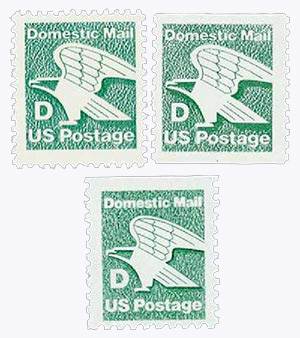
Late in 1981, after the rate had changed from 18¢ to 20¢, the Bureau of Engraving and Printing printed the non-denominated “D” stamp in anticipation of the next change in rate. For nearly four years, some 6.6 billion stamps – printed in sheet, coil, and booklet form – awaited distribution. Their moment finally came when the new 22¢ rate was approved. Like the previous alphabet stamps, this issue pictured a stylized eagle but was green in color.
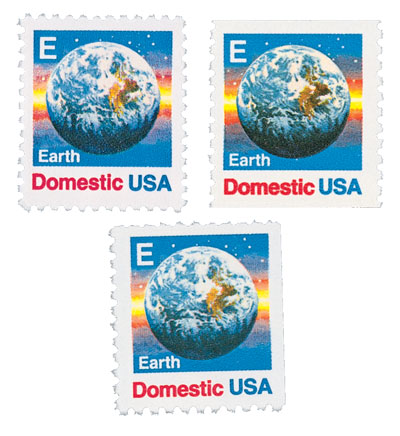
In 1988, following the USPS’s announcement that the first-class letter rate would change to 25¢, the non-denominated “E” stamp was issued. Responding to unfavorable comments concerning the “drab” appearance of the previous non-denominated issues, the Citizens Stamp Advisory Committee decided to link the stamp subject to the letter E. Shown from a moon’s-eye view, the dramatic “Earth” design appears almost three dimensional. It was printed in sheet, coil, and booklet forms.
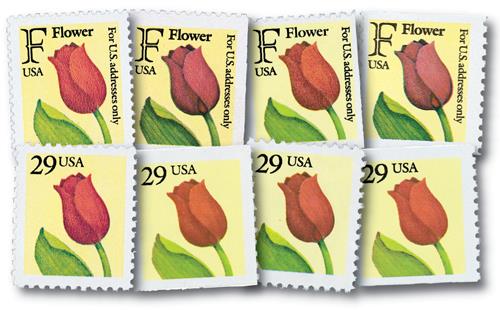
Prepared long in advance, the ‘F’ stamp was ready and waiting for the 1991 rate change. Like the 1988 ‘E’ stamp, the subject of this stamp, a single red tulip, was chosen to match the letter ‘F.’ Printing contracts were awarded to three different companies. The United States Bank Note Corporation was assigned to produce sheet stamps, the BEP printed coils and booklets, and KCS printed booklets. In addition to the Flower stamps, there was also a make-up rate stamp (#2521) and plastic flag stamp (#2522).
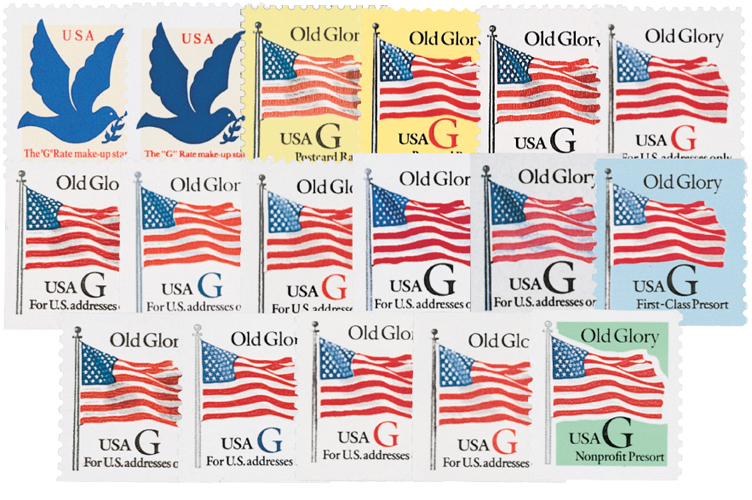
With a rate change scheduled for January 1, 1995, a new set of G-rate stamps were issued in December 1994 to make up the difference between the previous rate of 29¢ and the new rate of 32¢. This series was produced by more printers and in formats than any previous rate change stamps. Due to criticism of the 1991 make-up rate stamp received for its unattractive design, one stamp featured a flying dove with an olive branch in its beak. The American Bank Note Company and Stamp Venturers produced these stamps.
There were also a set of Old Glory stamps produced by the Bureau of Engraving and Printing, American Bank Note Company, Stamp Venturers, and Avery-Denison. They were available in sheet, coil, booklet, and self-adhesive booklet for vending machines. The yellow stamps covered the 20¢ postcard rate, the stamps with blue background were used on presorted first-class mail, and the nonprofit presorted stamps had a green background. All the Old Glory stamps with white backgrounds covered the new 32¢ postage rate.
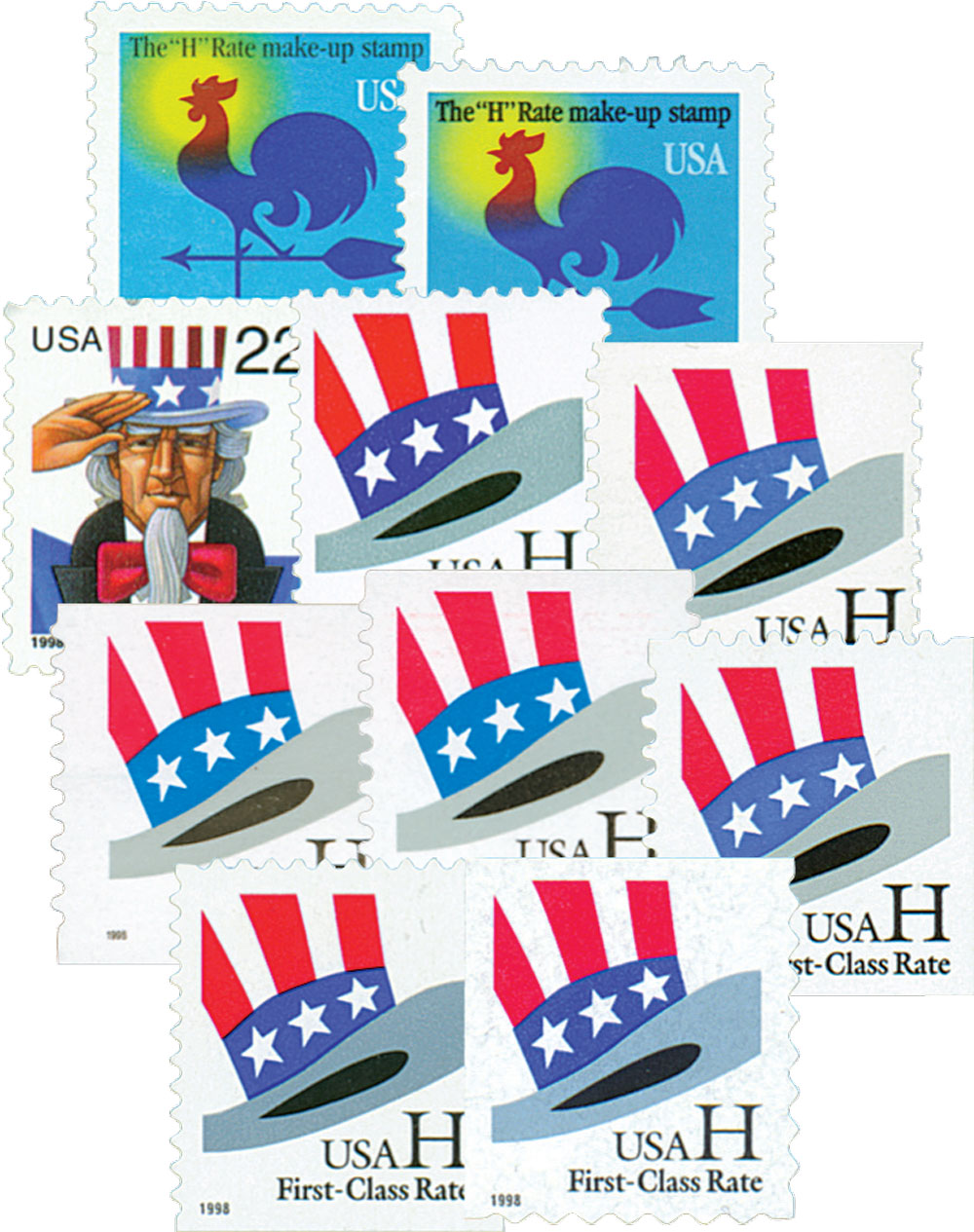
Due to pending postal rate increases in 1998, the US Postal Service issued a set of non-denominational stamps that feature “Uncle Sam’s hat” and weather vanes. The new postal rate, set at 33¢, went into effect January 1, 1999. The stamps were the first rate change alphabet stamps to be permitted on overseas mail.
The H-rate stamps were the final alphabet stamps, but rate change stamps would continue to be produced into the 2000s.
On November 1, 1981, a second postal increase, to 20¢, went into effect. Once again, the stylized eagle design was used and the background color was changed to brown. In addition to being printed in sheets and coils, the stamp was also printed in booklet format.
First Alphabet Rate Change Stamp
In the years prior, other stamps had been issued non-denominated for impending rate changes. Because postage rates for late 1975 were uncertain, both of the Christmas stamps that year (#1579 and #1580) were issued without denominations. These were the first non-denominated US stamps.
As postal costs increased, the USPS began to increase their rates for the various classes of mail. Before becoming effective, however, these rate increases had to be submitted to the Postal Rate Commission for approval. Often, the PRC would take as much as a year conducting studies and compiling data before accepting or rejecting the changes. If the rate increase was approved, the Postal Service then had to rush to design and produce the new stamps.

In 1975, after the rate had changed from 10¢ to 13¢, the Postal Service printed a new non-denominated stamp so it would be ready and waiting for the next rate change. A letter of the alphabet was used to represent the unknown rate, so the stamps could meet customer demand until new definitives bearing the actual rate were printed. When the rate increased in 1978 from 13¢ to 15¢, the first letter rate change stamps, #1735, 1736, and 1743, were put into use.

The Postal Service really kept its patrons on their toes in 1981 with two postal increases – one in March and another in November. Printed shortly after the 1978 rate change, the “B” stamps were put in storage until they were needed in 1981. The same stylized eagle used on the “A” stamp was also used for this stamp. The only difference between the two stamps was the background color – instead of orange, a rich purple was chosen. This issue was printed in sheets (perforated 11×10 1/2) and also in booklets (perforated 10). On March 22, 1981, the rate officially changed from 15¢ to 18¢.

On November 1, 1981, a second postal increase, to 20¢, went into effect. Once again, the stylized eagle design was used and the background color was changed to brown. In addition to being printed in sheets and coils, the C-rate stamp was also printed in booklet format.

Late in 1981, after the rate had changed from 18¢ to 20¢, the Bureau of Engraving and Printing printed the non-denominated “D” stamp in anticipation of the next change in rate. For nearly four years, some 6.6 billion stamps – printed in sheet, coil, and booklet form – awaited distribution. Their moment finally came when the new 22¢ rate was approved. Like the previous alphabet stamps, this issue pictured a stylized eagle but was green in color.

In 1988, following the USPS’s announcement that the first-class letter rate would change to 25¢, the non-denominated “E” stamp was issued. Responding to unfavorable comments concerning the “drab” appearance of the previous non-denominated issues, the Citizens Stamp Advisory Committee decided to link the stamp subject to the letter E. Shown from a moon’s-eye view, the dramatic “Earth” design appears almost three dimensional. It was printed in sheet, coil, and booklet forms.

Prepared long in advance, the ‘F’ stamp was ready and waiting for the 1991 rate change. Like the 1988 ‘E’ stamp, the subject of this stamp, a single red tulip, was chosen to match the letter ‘F.’ Printing contracts were awarded to three different companies. The United States Bank Note Corporation was assigned to produce sheet stamps, the BEP printed coils and booklets, and KCS printed booklets. In addition to the Flower stamps, there was also a make-up rate stamp (#2521) and plastic flag stamp (#2522).

With a rate change scheduled for January 1, 1995, a new set of G-rate stamps were issued in December 1994 to make up the difference between the previous rate of 29¢ and the new rate of 32¢. This series was produced by more printers and in formats than any previous rate change stamps. Due to criticism of the 1991 make-up rate stamp received for its unattractive design, one stamp featured a flying dove with an olive branch in its beak. The American Bank Note Company and Stamp Venturers produced these stamps.
There were also a set of Old Glory stamps produced by the Bureau of Engraving and Printing, American Bank Note Company, Stamp Venturers, and Avery-Denison. They were available in sheet, coil, booklet, and self-adhesive booklet for vending machines. The yellow stamps covered the 20¢ postcard rate, the stamps with blue background were used on presorted first-class mail, and the nonprofit presorted stamps had a green background. All the Old Glory stamps with white backgrounds covered the new 32¢ postage rate.

Due to pending postal rate increases in 1998, the US Postal Service issued a set of non-denominational stamps that feature “Uncle Sam’s hat” and weather vanes. The new postal rate, set at 33¢, went into effect January 1, 1999. The stamps were the first rate change alphabet stamps to be permitted on overseas mail.
The H-rate stamps were the final alphabet stamps, but rate change stamps would continue to be produced into the 2000s.







